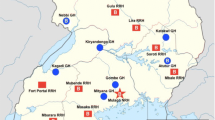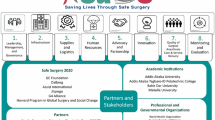Abstract
Introduction
Since 2007, observations reveal that low- and middle-income countries (LICs and LMICs) experience similar surgical access and safety issues, though the etiology of these challenges varies by country. The collective voice of surveys completed to date has pushed the agenda for the inclusion of safe surgery and anesthesia within global health discussions. Comparison of four countries across the world shows similar basic progress as well as ongoing surgical and anesthesia needs in resource-challenged countries. By studying these common needs, a comprehensive plan to provide infrastructure and personnel support can work in multiple austere settings.
Methods
A standardized survey tool published, designed, and developed initially by the Harvard Humanitarian Initiative and modified at Vanderbilt University was completed in Guatemala, Guyana, Laos, and Mozambique. The survey assessed eight key areas of essential surgical care: access to and availability of surgical services, access to human resources, essential infrastructure (including access to water, electricity, sanitation, blood products, and essential medicines including supplemental oxygen), surgical outcomes, operating room information and procedures, equipment, International Organization, and Non-Government Organization provision of surgical care. These results were compared and contrasted to evaluate resource challenges and assets in each country.
Results
A total of 49 hospitals were surveyed in this comparison cohort. The results reveal common needs for emergency and essential surgery in each country, but some differences in human and capital resources exist. While minimal resources exist, all surgical sites provided running water, electricity, and oxygen—assets not seen in previous surveys as recent as 2011.
Conclusion
The most basic needs to provide essential surgery are now present in LICs and LMICs. Many more resources are needed to ensure access to safe surgery and anesthesia. The next steps to provide essential surgery must include common solutions for access to surgery and anesthesia, and an evaluation of patient safety in these endeavors through the perioperative mortality rate.
Similar content being viewed by others
References
Standards, Guidelines, Statements and Other Documents American Society of Anesthesiologists. https://www.asahq.org/For-Members/Standards-Guidelines-and-Statements.aspx. Accessed 4 Oct 2014
Higashi H, Barendregt JJ, Kassebaum NJ, et al (2015) Burden of injuries avertable by a basic surgical package in low- and middle-income regions: a systematic analysis from the global burden of disease 2010 study. World J Surg 39(1):1–9
Mathers CD, Loncar D (2006) Projections of global mortality and burden of disease from 2002 to 2030. PLoS Med 3(11):e442
Disease Control Priorities Project (2013) Disease Control Priorities, Third Edition. http://www.dcp-3.org/. Accessed 4 Oct 2014
Funk LM, Weiser TG, Berry WR et al (2010) Global operating theatre distribution and pulse oximetry supply: an estimation from reported data. Lancet 376:1055–1061
Weiser TG, Regenbogen SE, Thompson KD et al (2008) An estimation of global volume of surgery: a modeling strategy based on available data. Lancet 372:139–144
Kaiser Family Foundation Births Attended by Skilled Health Personnel. http://kff.org/global-indicator/births-attended-by-skilled-health-personnel/. Accessed 4 Oct 2014
WHO Guatemala. http://www.who.int/countries/gtm/en/. Accessed 4 Oct 2014
Murray CJ, Ezzati M, Flaxman AD et al (2012) GBD 2010: a multi-investigator collaboration for global comparative descriptive epidemiology. Lancet 380(20550):2
Thind A, Mock C, Gosselin RA et al (2012) Surgical epidemiology: a call for action. Bull World Health Organ 90:239–240
Vansell HJ, Schlesinger J, Harvey A, et al (2015) Anaesthesia, surgery, obstetrics, and emergency care in Guyana. J Epidemiol Glob Health 5(1):75–83
World Bank. Guatemala. http://data.worldbank.org/country/guatemala. Accessed 4 Oct 2014
World Bank Guyana. http://data.worldbank.org/country/guyana. Accessed 4 Oct 2014
World Bank Laos. http://data.worldbank.org/country/lao-pdr. Accessed 4 Oct 2014
World Bank Mozambique. http://data.worldbank.org/country/mozambique. Accessed 4 Oct 2014
Trends in Maternal Mortality: 1990 to 2013. Estimates by WHO, UNICEF, UNFPA, The World Bank and the United Nations Population Division. http://apps.who.int/iris/bitstream/10665/112682/2/9789241507226_eng.pdf?ua=1. Accessed 4 Oct 2014
Kaiser Family Foundation Health Workforce and Capacity Indicators. http://kff.org/global-indicator/physicians/. Accessed 4 Oct 2014
Author information
Authors and Affiliations
Corresponding author
Rights and permissions
About this article
Cite this article
Merchant, A., Hendel, S., Shockley, R. et al. Evaluating Progress in the Global Surgical Crisis: Contrasting Access to Emergency and Essential Surgery and Safe Anesthesia Around the World. World J Surg 39, 2630–2635 (2015). https://doi.org/10.1007/s00268-015-3179-1
Published:
Issue Date:
DOI: https://doi.org/10.1007/s00268-015-3179-1




